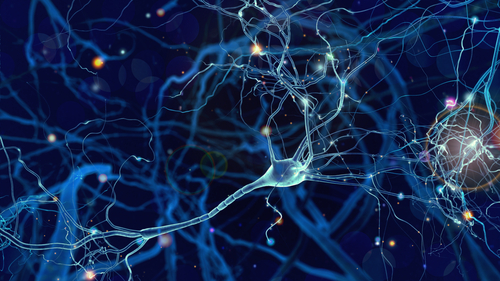Better Repair of Nerve Insulation May Lead to New MS Treatments

There may be a better way of repairing the insulation surrounding damaged neurons that could lead to new treatments for multiple sclerosis (MS), a study suggests.
The data showed that blocking the protein sphingomyelin hydrolase neutral sphingomyelinase 2, or nSMase2, could improve the quality of the myelin surrounding nerve cell fibers, and stabilize its structure. nSMase2 is responsible for breaking down sphingomyelin, which is a type of lipid (fat) molecule present in that protective myelin sheath.
The study, “Inhibition of neutral sphingomyelinase 2 promotes remyelination,” was published in the journal Science Advances.
MS is caused by the attack by immune cells to the body’s own myelin, a fatty insulation provided by oligodendrocyte cells that cover the long branches that extend from nerve cells, which are called axons. When myelin is destroyed — called demyelination — the connections between neurons become defective and MS symptoms arise.
Most individuals with relapsing-remitting MS (RRMS), an intermittent form of multiple sclerosis, have acute episodes of demyelination. RRMS may evolve to secondary progressive MS (SPMS), in which progressive neurological deterioration occurs and myelin can no longer repair itself.
“Suppressing the immune system has worked to treat relapsing-remitting MS, but it doesn’t protect from the eventual advancement to progressive MS, for which there aren’t any good treatments on the market,” Norman Haughey, PhD, professor of neurology at the Johns Hopkins University School of Medicine and the study’s senior author, said in a press release.
Now, a team led by researchers at Johns Hopkins suggested that the use of certain compounds may be able to prevent RRMS from evolving to SPMS.
In previous studies, the team analyzed the composition of the myelin surrounding nerves near injury sites in the brain tissue of cadavers with MS. Compared with other nerves, these looked misshapen and had higher levels of ceramide and lower levels of sulfatide — both lipid (fat) molecules.
Ceramide plays a role in MS by regulating the curvature and compaction of myelin. However, when in excess, it can form bumps on the surface of myelin preventing it from wrapping tightly around nerves.
In the new study, the team analyzed modifications in the lipid composition of myelin following remyelination in cuprizone-treated mice — a mouse model of MS in which myelin loss and oligodendrocyte destruction are caused by the toxic agent cuprizone. Cuprizone was given to the mice through their diet for 26 days.
The results showed that the myelin was able to repair itself, although the increase of ceramide produced a disorganized and decompacted myelin structure. The researchers believe the overproduction of ceramide during remyelination is the result of the action of the enzyme nSMase2 that converts sphingomyelin to ceramide. nSMase2 is activated by brain inflammation.
Oligodendrocyte progenitor cells (OPCs) are activated and recruited to damaged sites following demyelination. These cells then differentiate into myelinating oligodendrocytes to repair denuded axons. For oligodendrocyte regeneration, inflammation is functionally important.
The scientists showed that inflammatory cytokines, namely tumor necrosis factor-alpha (TNF-alpha) and interleukin-1beta (IL-1beta), promote a protective and regenerative response in OPCs. However, that turns into a harmful response, promoting apoptosis (cell death) as the OPCs differentiate into oligodendrocytes.
Moreover, in experiments using antibodies (immunostaining), the researchers found that the response of OPCs and oligodendrocytes to inflammatory cytokines may be regulated by the nSMase2 enzyme. Through further investigation, the team found that the expression of nSMase2 modifies the cellular response to inflammatory cytokines such as TNF-alpha.
“Our findings suggest that expression of nSMase2 modifies the cellular response to inflammation, from being protective in OPCs (when nSMase2 is not expressed) to damaging in myelinating oligodendrocytes,” the researchers wrote.
The team then assessed whether pharmacological inhibition of nSMase2 protected myelinated axons. This was done by testing cambinol, a compound that blocks nSMase, in the cuprizone mouse model. The results showed that blocking nSMase2 prevented the increased production of ceramide and its incorporation in regenerated myelin.
Next, the researchers determined whether inhibition of nSMase2 during the remyelination process modified the lipid content of myelin. The mice were fed a cuprizone-containing diet for 28 days, to induce myelin damage. This was followed by cambinol for 28 days, after which the mice were returned to a normal diet.
Cambinol treatment caused the myelin to grow back tightly around the nerve cells; the myelin produced appeared as it did before the cuprizone-induced damage. The treatment did not completely restore the lipid composition of myelin, but appeared to increase its stability protecting neurons, the team noted.
Finally, genetic deletion of nSMase2 in myelinating oligodendrocytes also was found to normalize the amount of ceramide and increase the thickness and compaction of myelin, thus stabilizing the structure of remyelinated axons.
“Pharmacological inhibition or genetic deletion of nSMase2 in myelinating oligodendrocytes normalized the ceramide content of remyelinated fibers and increased thickness and compaction. These results suggest that inhibition of nSMase2 could improve the quality of myelin and stabilize structure,” the researchers wrote, adding that “a more stable myelin structure is likely to be less susceptible to secondary demyelination.”
“We think these findings are a big step toward improving the quality and composition of myelin following a flare-up,” Haughey said.
The team now plans to determine the impacts of other abnormal lipid levels, apart from ceramide, and determine if myelin maintains its function when returned to its correct structure. After this, the researchers hope it will be possible to consider inhibitors of nSMase2 for use in human trials.






